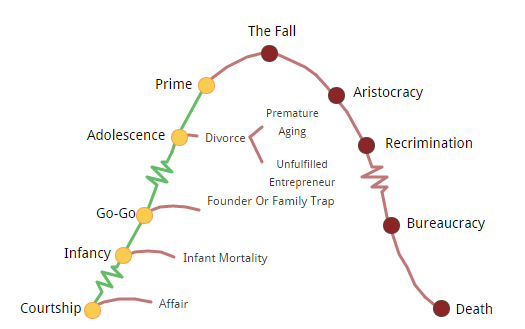Industry and company lifecycles
I was first introduced to the concept of company life-cycles in 1997. Working for a US manufacturer overseas, our President hired a consultant by the name of Adizes to take us through a 2 day workshop to understand the potential growing pains our company would go through over the next 10 years. Completely prescient.
Companies are like people and go through different stages of development, maturity, and decay. At each of these stages, there are challenges that must be overcome, for the company / organization to continually grow and succeed. There are “traps” that companies can fall into such as “infant mortality” and “divorce”
Fast forward 17 years, and I recently came across Bains’ thinking called Founder’s Mentality. There is a prolific blog here and it’s a great way to think about sustainable growth. There are constant tensions between corporate youth and maturity.
At it’s core, the idea is simple. Small companies start with a spark, a passion, and a mission. Bain makes a compelling, if sometimes obvious, case that companies lose this magic over time for many reasons. You see this from all the major case studies from MBA days – Dell computer, Southwest, and Starbucks; small, scrappy companies become the stalwarts they were fighting against in the early days.
Bain has done a lot of thinking on strategy and growth and when they looked at corporate annual reports, 80%+ of companies state they plan to outgrow their markets by 2x. Unsurprisingly, only few achieve these lofty goals. Digging further, Bain discovered that these companies did not blame the market or the environment; no, they blamed themselves and internal reasons:
- Organizational complexity
- Problems with culture
- Lack of resources
- Inability to focus
- Weak business plans
- Lack of capabilities
However intuitive this point, Bain & Company does a great job describing this organizational inertia (nimble companies get fat) and what they can do about it. The fastest ways to grok this content is to watch this video on the Founder’s Mentality here.
Consultants love 2×2 matrix and Bain is no exception to this rule. Mapping out Founder’s Mentality vs. Big Company Scope and Scale, you can see the most typical pathway is for new small companies to start in the bottom right (lots of magic, no scale), and as they become more successful, profitable and larger, they lose this mentality. These companies go from being “insurgents” to being “incumbents”.
Bain describes the factors that push companies WEST (losing the Founder’s Mentality) and SOUTH (losing the SCALE and SCOPE). For those of us who have worked for / consulted for Global 500 companies, much of this dysfunction will sound familiar.
Westward winds = 4 ways that founder’s mentality dies
Bain describes 4 different forces that sap the founder’s mentality out of firms, pushing them to the west on the 2×2 matrix. Simple description here.
- The unscalable founder
- Lost voices from the front line
- Revenue grows faster than talent
- The erosion of accountability
Southward Winds: How companies lose the power of scale
There are another set of forces taking away the benefits of scale, pushing the organizations southward on the 2×2 matrix here.
- The complexity doom loop
- Death of the nobler mission
- The curse of the matrix
- Fragmentation of the customer experience
I am a big believer in lifecycles. Lifecycles apply to products, companies, and relationships. Almost everything in life. Life is not linear, but rather a series of ups/downs and S-curves. Even this blog has a lifecycle; the content, the readership, the tone and tenor are continually evolving. The Founder’s Mentality video is here and it is the best thinking on corporate lifecycle I have seen in. . . 17 years.

